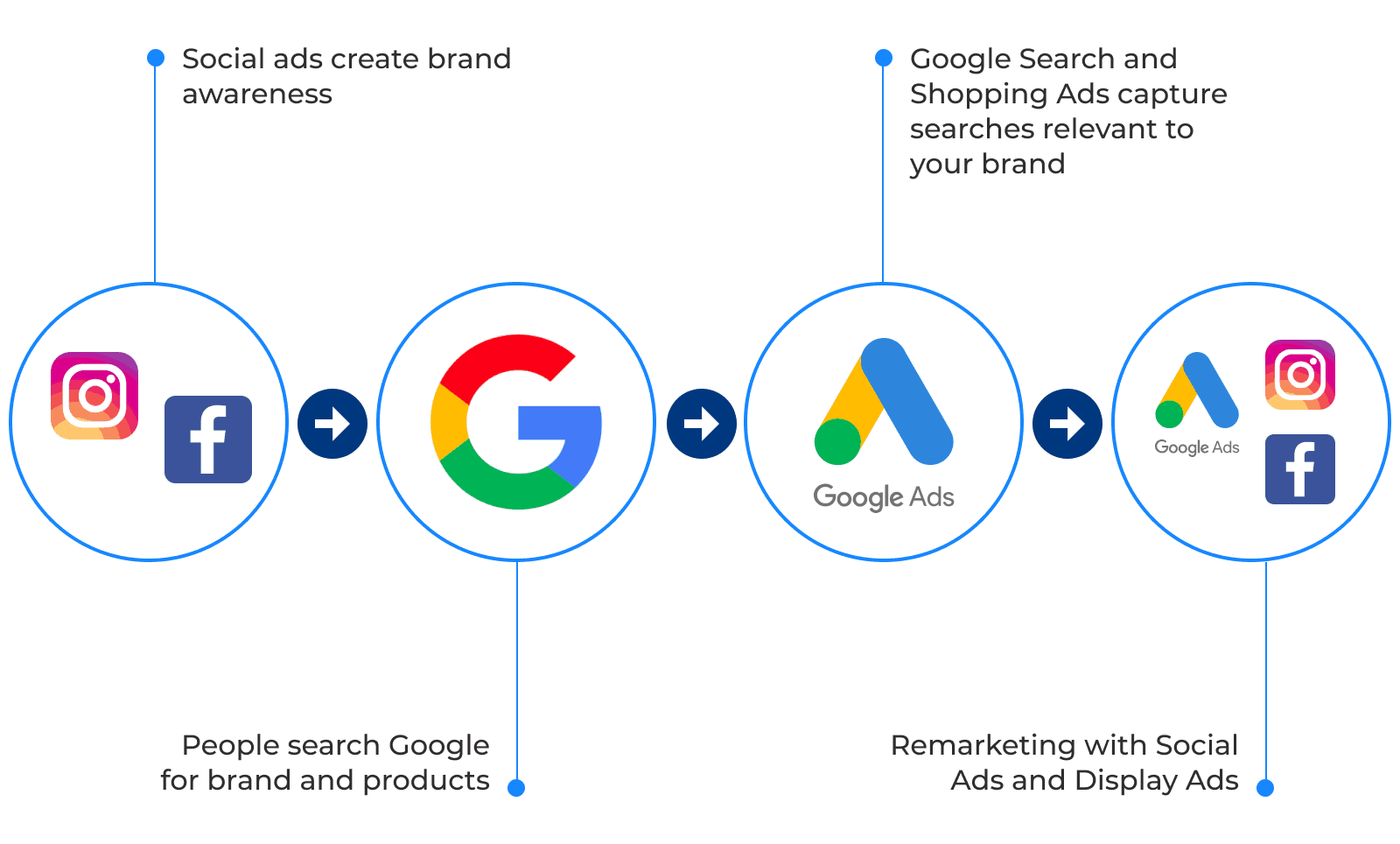Gone are the days when you had to take out some time from your busy schedule and wait in the long que to shop. As in this technological era, you can shop at any time just by sitting at any corner of the world. That’s right, I am here talking about online shopping. And, now after the 2020 pandemic, with reduced physical stores, people are heading towards contactless delivery and conversational commerce and mobile ordering, popularizing eCommerce than ever before. So, in order to offer a better customer experience, the companies must create some significant digital commerce strategies that could deliver a much personalized experience to the valuable customers. This article is all about how the companies can develop such strategies and reach their business goals and aspirations.
10 strategies to adopt
Let’s begin by looking at the various ways in which a company can skillfully develop the necessary digital commerce strategies.

Understanding your customers’ choices and preferences
You can get to know your customer by creating a unified first-party data strategy which can provide a better context into your customer’s choices, behaviors, preferences and interactions with your brand. By the help of a customer data platform (CDP) you are able to collect data from a broad variety of sources, unify them into a master record in order to provide a single view of each customer. A CDP enables you to bring together various types of e-commerce data like operational data, transactional data, promotional data, behavioral attribution data and customer and product data brick-and-mortar data. Therefore, an organization's customer data platform not just simply collects all of these data points, but also combines, dedupes and enhances this information via procedures such as identity resolution which helps in ensuring that everyone is working perfectly, just like a 360-degree view of every customer.
Unifying both offline and online engagements
Commerce can no longer be considered as a single channel strategy or a virtual shopping cart button which you simply add to the corner of your website. Instead of thinking of commerce as only a single transactional channel, retailers need to adapt their mindset in considering the complete customer journey, offline and online. Also, a CDP unifies consumer interactions, purchase history and other data points in real time enabling in-store employees and service representatives to deliver the similar personalized, consistent experiences to consumers while they move from channel to channel.
Leveraging machine learning models and predictive analytics
To get a better insight about your customers, you can make proper use of techniques such as predictive machine learning models and AI-driven recommendations to deliver customers the right content at any phase in their journey. Learn more about content-driven commerce here.
Making investment in a composable commerce architecture
Composable commerce provides businesses the authority to adapt and expand their commerce experiences via modular components and business applications which can be deployed and reused over several new interfaces and channels without any limits. Unlike monolithic e-commerce platforms which restrict business growth from vendor lock-in, composable digital commerce built with a microservices-based architecture enable business users to smoothly build and integrate with their complete technology stack and add new touchpoints. This flexible, open architecture helps brands in maximizing their investment as the e-commerce landscape continues to progress. Learn more about composable enterprise and its significance here.
Developing cross-functional collaborations
What if in your organization all the teams including Sales, Marketing, IT and Development happen to work in a silo? You could really be in great trouble. Even though it is difficult, you need to form a cross-functional team that consists of business and technical stakeholders, embracing the concept of DevOps while you work upon a digital commerce strategy.
Defining business needs and requirements
Without defining the business requirements, it is just a waste of time and effort to launch digital commerce as it can even leave big brands in trouble. Therefore, it is important to define the goals and objectives of your digital commerce that includes enhancing customer experience, maximizing digital revenue, reducing customer churn, reaching out to new markets, and also retaining the repeat customers. And based on these goals, you shall define the necessary KPIs.
Identifying the right technical architecture
After the customer experience is defined depending upon the touchpoints, you need to select an ideal digital commerce platform such as CMS, CRM, DXP and DAM for your business which tends to integrate with front-end customer touchpoints, back-end applications, and external services for the purpose of delivering the best customer experience.
Understanding your direct competitors
One of the essential steps to be taken while creating an online strategy is to clearly understand how online sales presently work in your industry. You can start by noticing and understanding market leaders and your direct competitors to recognize the best practices and also their positioning.
Maintaining data protection and privacy
In today’s times, a majority of online shoppers are seen being concerned about their data that includes sensitive information like their phone number, address, credit card information, and much more. Everybody is worried about what the organizations are doing with their data. By adopting the essential security steps you can ensure that your organization not just comply with new privacy regulations but also looks forward in building trust with the customers.
Recognizing your exclusive value proposition
Today the online customers are smart enough to do a lot of research before making any purchase. They would certainly compare the products or services that you’re offering to those of your competitors. You need to recognize your brand’s unique value proposition and even make it clear to your customers. Also, the value proposition answers an important question which every e-commerce customer asks: “Why shall I buy from you instead of your competitors? So, you need to think about such perspectives as well. Learn more about how to deliver the perfect digital commerce experience to your customers here.
The state of digital commerce strategy in 2022
This section will provide you some of the finest eCommerce strategies for 2022. So, if you want to succeed you must take a look at it.
Implementing Google Shopping Ad
One of the most popular strategies among most of the online retailers is the ad platform Google Shopping. This platform happens to put related products in front of consumers at the time of shopping online.
Using Facebook and Instagram Shopping
You can never miss out on social media advertising campaigns while considering your eCommerce strategies in 2021 and it’s going to be pretty much the same in 2022 as well. Social selling can be considered as a large market for many of the online retailers. This platform enables you to directly sell products via social media sites like Instagram, Facebook and Pinterest. According to recent studies based on the impact of social media ads, people surveyed confirmed that they consider brands on Instagram as popular (78%), creative (77%), entertaining (76%), and relevant (74%).

Adding product structured markup language
If you are looking to execute better marketing strategies, then your organization shall start adding structured markup language to your product pages. It helps in proper search engine indexing, also providing the search engine the capacity to clearly understand information on a given page.
Prioritizing product SEO
Search Engine Optimization (SEO) is essentially important for your product page. You need to always include keywords in your product page, so it is more possible to rank higher in a search. Basically, it is worth investing in SEO. For example, you can start by simply including a title tag and meta description which incorporates optimized keywords or a keyword-rich product description. No matter whichever method you opt for, the prime focus shall be on using the right SEO keywords in order to generate higher rankings in searches. Access this complete guide on SEO to know more.
Adding videos to every best-selling products of yours
Videos can really increase the sales of your products if you use them in the right way. Below are some stats on videos and eCommerce:
- 89% of video marketers express that video provides them a good ROI.
- 83% of video marketers express that video helps them with lead generation.
- 87% of video marketers express that video has increased traffic to their website.
- 80% of video marketers express that video has increased direct sales.
- 95% of video marketers plan to increase and even maintain video spend in 2020.
You even have the option of connecting to influencers and asking them to review your product in a video or film an informative video on one of your products. It can help in boosting your eCommerce.
Making the checkout process easier with just one click
You need to ensure that your customers experience the minimum traffic on their way to make a purchase. So, if anything slows the customer down, then it is considered as friction. Therefore, friction is just not a good thing. You should always focus on letting your customers shop quickly and smoothly as possible. Also, you will be happy to know that friction can be reduced simply with one-click payment programs such as Apple Pay or Google Pay, enabling your customers to easily place their orders with much less hassle.
Selling your products on Amazon, eBay, Rakuten, and others
You should never restrict your business to just one single market. Indeed, you significantly markup your eCommerce sales by diversifying your portfolio and expanding your product to new platforms. The companies can easily sell their licensed products on Amazon, eBay, or Rakuten with in fact having little to not much change in the selling process.
Signing up for review generators such as Trustpilot
Well, we all know that maximum numbers of customers today prefer reading reviews before making any purchase. Therefore, consumer reviews are very significant for your organization. Although, you can go for advertising positive reviews, but the negative ones can really bring you trouble. So, programs such as Trustpilot can be very helpful while trying to manage and track the reviews of the customers. Also, it can help you in generating positive reviews which you can advertise on Google, Facebook and Instagram. You can even track and filter positive and negative feedback which will further help you in highlighting the good and focus on solving the bad.
Executing an affiliate marketing campaign
Similar to influencer marketing, we have one more revenue-generating avenue for eCommerce brands which can be called affiliate marketing programs. These programs can be considered as commission-based programs, where an individual is able to promote your product and also can receive a commission for each sale they drive for your website. This kind of marketing can improve your eCommerce since you are able to easily track and record clicks, in order to know who exactly the successful affiliate marketers are.

Offering coupons regularly
Are you aware that you can effortlessly increase your eCommerce with some interesting coupons? These coupons can offer discount codes for your customers, encouraging them to make any purchase. For instance, you can give “First Time Discounts” to your new customers. Such types of on-the-spot discounts can be a good way to convince a first-time customer to easily make a conversion. At the same time, it can be a great way to integrate them into your brand. Additionally, first-time discounts enable you to collect customer emails and also add them to your email marketing subscription list. So, by providing these coupons on a frequent basis, particularly over email leads to more recurring customers.
Growing eCommerce via text messages
Let me tell you, according to statistics provided by OuterBox, an estimated 79% of smartphone users actually made an online purchase through their mobile phones. It is near about 17% increase from 2019. With the help of text message marketing, your business can target and connect with potential customers. It can be also termed as SMS marketing. Also, one of the main advantages of sending a text message to customers can be personalization. You can personalize every single message and build a good relationship with your valuable customers. Additionally, you can send coupons, discounts, information on upcoming sales and new products via a simple text.
Final thoughts
Every organization is different. So, depending on your needs and specifications, you can smartly select digital commerce strategies which suit your business model. You will find a whole lot of options when it comes to strategies, so choose wisely. Drupal can be a perfect fit for your digital commerce endeavours, here’s how.
Subscribe
Related Blogs
Trek n Tech Annual Retreat 2025: A 7-Day Workcation of OSL

OSL family came together for the Trek n Tech Annual Retreat 2025, a 7-day workcation set amidst the serene beauty of…
Exploring Drupal's Single Directory Components: A Game-Changer for Developers

Web development thrives on efficiency and organisation, and Drupal, our favourite CMS, is here to amp that up with its…
7 Quick Steps to Create API Documentation Using Postman

If you work with API , you are likely already familiar with Postman, the beloved REST Client trusted by countless…




